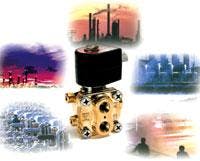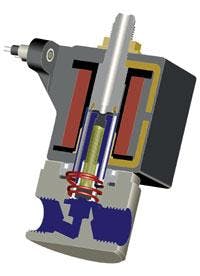By Richard Condon
Solenoid valves are used extensively in processes across numerous industries, including: water and wastewater, power, offshore, chemical, pulp and paper, and food and beverage processing. It is a bit surprising, then, how often they are misunderstood. For example, many do not know that a solenoid valve in one of these applications will likely never come in contact with the media in question, whether chemical, water, or otherwise. Yet, solenoid valves remain an essential part of systems such as these.
Fundamentals
Solenoid valves use electricity to open and close an orifice in the valve body, allowing or preventing a medium to flow through. In order to choose the best possible solenoid valve for an application, it is important to understand the valve's workings.
A solenoid valve in its simplest form is opened and closed through the use of a plunger, which is raised and lowered by the energizing and de-energizing of a solenoid. The magnetic field created by the solenoid's coil turns the valve's stop into an electromagnet, attracting and raising the steel plunger. A corresponding spring then compresses as the orifice opens. Upon de-energizing, the magnetic field is discontinued and the spring expands, forcing the plunger back onto the orifice and shutting off flow.
Any given solenoid valve can contain numerous materials. When applications arise with corrosive, hazardous or other harsh environments, the valve's parts can be degraded. In most cases, this issue is addressed by modifying the valve's construction to only include those materials that cannot be degraded by the agents inherent to the application. For example, valves can be constructed of varying grades of stainless steel, plastic, or of more unusual materials if needed. However, for normal environments and room temperature conditions, the majority of external solenoid valve components are brass, stainless steel, and/or aluminum.
Uses
It is a common misconception that a solenoid valve, by its nature, will be used in any application to control the actual media being moved, whether chemical batches, water or wastewater, beverages, etc. In fact, in these industrial applications, it is most likely that the solenoid valve will never come directly in contact with that medium. Instead, the valve will be used as part of a package which controls the larger system: solenoid valve, actuator, process valve. Each performs separate functions:
• The solenoid valve is used to move air in and out of an actuator. No other component can quite replace a solenoid valve in these applications. Others may have similar characteristics; however, solenoid valves operate with electricity, thus, do not have to be energized and de-energized manually. This saves time; promotes precise, repeatable system performance; and limits the possibility of employee accidents.
• The actuator turns, moving the larger process valve.
• The process valve moves the medium through the system. Numerous types of process valves can be used, depending on application requirements and, most importantly, the medium which it will control. Some examples of process valves are: globe, gate, plug, quarter-turn, check, etc.
As an ancillary benefit, solenoid valves in this setup can also be used to provide a safety shut-off feature. When power to the valve's coil is removed, the valve automatically closes, thereby shutting down the three-part system.
How to Buy Them
Another misconception involves purchasing. Many may be thinking, "I've never called a solenoid valve manufacturer. Do I need to add another new vendor to my already-interminable list?"
The answer is no. In fact, most people involved in specifying components for these applications will never need to deal directly with a solenoid valve manufacturer. Valve actuation centers (VACs) are designed to provide customers with holistic application solutions. Based upon details provided by the customer, VAC employees are trained to ask the necessary questions about the application and to recommend an appropriate "package," including the solenoid valve, actuator, and process valve.
However, this does not change the fact that the buyer should know as much as possible about the components before making a purchase. VAC employees, used to working with a particular solenoid valve manufacturer or with a specific model solenoid valve, may not offer the full gamut of possibilities. While the valves they sell may be good for the application, there could very well be a new product on the market that is even better. Likewise, in highly specialized cases where the application is too tricky or dangerous for a generic solution, a customer can go directly to the solenoid valve manufacturer to match an appropriate solenoid valve to the application.
There is some general information that is always necessary to make a correct solenoid valve specification. Before going to a VAC, be sure to consider these application questions:
• Valve type needed (two-, three, or four-way)
• Voltage
• Maximum and minimum operating pressure differentials
• Pipe size/process connection
• De-energized position (normally open or closed, etc.)
• Ambient conditions
• Agency approval(s) required (UL, CSA, FM, CENELEC, etc.)
• Coil/connection type
• Current draw limitations
• Duty cycle (continuous, intermittent, etc.)
• Electrical enclosure type
• Life expectancy (minimum expected cycles per year)
• Orifice diameter
• Allowable internal leakage
• Electrical enclosure ratings (NEMA 4, 7, 9, etc.)
At this point, go through the application specifications with the specialist, making sure that special needs are taken into consideration. The most important features for customers in these industries are long life, durability, reliability, and available options. Be sure to find out information such as:
• Can the VAC provide solenoid valves for hazardous applications, such as NEMA-rated and/or intrinsically safe valves?
• What is the life expectancy of the valve? In comparison to the actuator?
• Is the valve's construction set up to resist debris and other matter that can build up and hinder reliability and performance?
• What mounting options are available —- i.e., pipe mount (NPT) or direct mount (NAMUR pattern)?
• Are there money-saving options available, such as low-power consumption coils?
• Are there system-enhancing options available, such as pilot guards or quick-exhaust design?
The Results
For many industries, a system failure can result in an unplanned shutdown. With this comes associated labor time and cost, lost batches of product, reduction in productivity, and, overall, lost money. No one wants to lose money because of a small component like a solenoid valve. Knowing how they work, how they are used, and how they fit into the application can allow a proper specification; thereby ensuring the most reliable system possible.
About the Author:
Richard Condon has been employed at the Fluid Control Division of Parker Hannifin for the past eight years. His extensive product knowledge has developed from his experience as a technical representative, product specialist, technical team leader and currently as a market specialist working with valve actuation, mobile, fuel cell and industrial equipment accounts. He received his Bachelor of Science degree in industrial technology from Central Connecticut State University.




